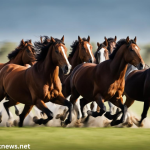Horses, with their grace and power, have long captured the human imagination. Their journey from wild herds roaming the steppes to beloved companions and invaluable partners in work and sport is a testament to their adaptability and enduring bond with humans. This article delves into the majestic journey of horses, exploring their origins, domestication, and the multifaceted roles they play in our lives today. Check here for more francechevalturf.
Origins in the Wild
The ancestors of modern horses roamed the Earth millions of years ago. Fossil evidence traces their lineage back to the small, dog-sized Eohippus, which lived around 55 million years ago. Over millennia, these early equines evolved, adapting to changing climates and landscapes, gradually increasing in size and speed. By the Pleistocene epoch, around 2.6 million to 11,700 years ago, the predecessors of today’s horses had developed the physical characteristics we recognize today: long legs, powerful bodies, and a single, sturdy hoof on each foot.
Domestication: A Turning Point
The domestication of horses is believed to have begun around 6,000 years ago on the steppes of Central Asia, particularly in regions that are part of modern-day Ukraine, southwest Russia, and west Kazakhstan. This transformative event marked a significant turning point in human history. The early domesticated horses were likely used for their meat and milk, but their speed and strength soon led to their use in transportation and warfare.
The Botai culture, which flourished around 3500-3000 BCE in what is now Kazakhstan, is one of the earliest known to have domesticated horses. Evidence from archaeological sites, including bit wear on horse teeth and residues of mare’s milk in pottery, suggests that these early people not only rode horses but also relied on them for sustenance.
Horses in Ancient Civilizations
As horses became more integral to human societies, their roles expanded. In Mesopotamia, Egypt, and later in Greece and Rome, horses were essential for chariots and cavalry, revolutionizing warfare and transportation. In these ancient civilizations, horses were often symbols of power and prestige, owned by the elite and depicted in art and literature.
In China, horses were crucial for the military campaigns and the expansion of the Silk Road, facilitating trade and cultural exchange across vast distances. The famed Terracotta Army of the first Emperor Qin Shi Huang includes numerous horse statues, underscoring their importance in ancient Chinese society.
The Medieval and Renaissance Eras
During the medieval period, horses were indispensable to knights and armies across Europe. The breeding of larger, stronger horses capable of carrying armored knights led to the development of the destrier, a powerful warhorse celebrated in medieval literature and tournaments. Horses also played critical roles in agriculture, pulling plows and carts, which increased food production and supported growing populations.
The Renaissance saw a renewed interest in the art and science of horse breeding, training, and riding. The development of classical dressage and the establishment of riding schools, such as the Spanish Riding School in Vienna, highlighted the sophistication and elegance of equestrian pursuits.
Modern Equine Roles
Today, horses continue to be cherished companions and partners in various domains. In sports, they excel in disciplines such as racing, show jumping, dressage, and eventing. The bond between horse and rider is paramount, requiring trust, communication, and mutual respect.
Horses also serve in therapeutic settings, providing emotional and physical benefits through equine-assisted therapy programs. Their gentle nature and intuitive responses can help individuals with disabilities, trauma, and other challenges.
In agriculture and rural communities, horses remain valuable for tasks like herding livestock and logging, particularly in areas where machinery is impractical. Additionally, they play ceremonial roles in parades, police work, and state functions, symbolizing tradition and continuity.
The Enduring Bond
The relationship between humans and horses is a remarkable journey of mutual adaptation and shared history. From their early days as wild animals to their current status as beloved companions and athletes, horses have profoundly influenced human culture and society. Their majestic presence continues to inspire awe and admiration, reflecting the deep and enduring bond we share with these incredible creatures.










